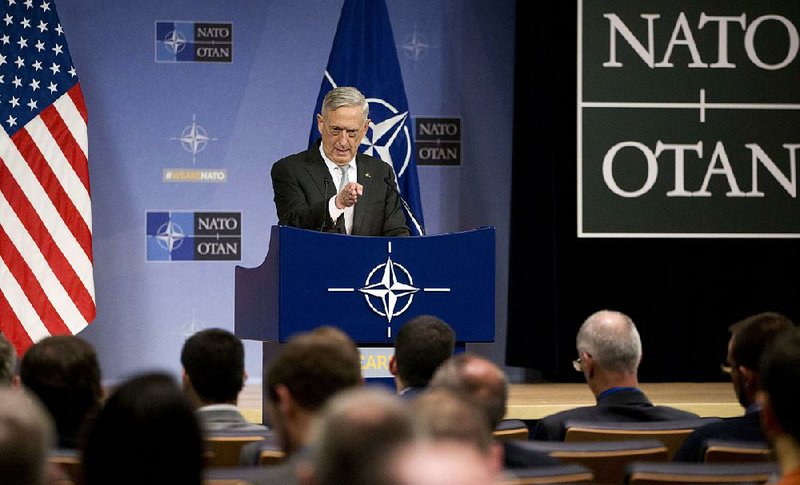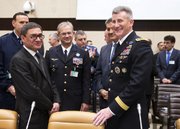BRUSSELS -- After months of lobbying NATO allies to increase their troop contributions and support to the war in Afghanistan, the alliance came up short Thursday, meeting a bit more than 90 percent of the military requirements mapped out by commanders, according to NATO officials.
U.S. military leaders, however, said they have been encouraged by the continuing discussions with several nations that may eventually agree to increase their commitments.
"Coming out of today, it won't be at 100 percent today," said U.S. Army Gen. Curtis Scaparrotti, NATO's top military officer. "We're still in discussion with more than a few nations that are looking at an increase above the initial one given at the force generation conference. So, I'm encouraged."
The gap, said Gen. John Nicholson, top U.S. commander for Afghanistan, has contributed to the lowest level of capabilities and the "highest level of risk we faced" in the 16-year war.
Nicholson and Scaparrotti declined to provide details on the numbers, but other NATO officials confirmed that coming out of the meeting Thursday there would be a shortfall approaching 10 percent. The officials weren't authorized to discuss the numbers publicly so spoke on condition of anonymity.
NATO defense ministers were meeting to provide their countries' latest decisions on troop contributions, under pressure from U.S. and NATO leaders to beef up their commitments. Defense Secretary James Mattis sent letters to some allies in recent weeks urging them to fill critical gaps.
The additional trainers are critical to reaching the stated U.S. and NATO goal of building up the Afghan forces so that they can take control of their own country's security. At the same time, officials want to use the increased military pressure to force Taliban leaders to the peace table.
Scaparrotti told reporters that there will still be a need for additional trainers and advisers, particularly at schools for Afghan forces.
"This is a complex world, and there's a lot of demand on the military, and so all these nations have to make hard choices between Afghanistan, internal responsibilities and other missions," Scaparrotti told reporters traveling with Mattis.
"We also have budget constraints that each of the nations are dealing with. It's just a fact of life today."
Nicholson told reporters that he needs nearly 16,000 troops to fill the NATO training mission in Afghanistan. That number does not include other support missions or counterterrorism operations against the Taliban, Islamic State militants and other insurgents.
Nicholson said he is most concerned about getting enough trainers and advisers for the Afghan commandos, the Air Force, and the schools where the military and local police are trained. In addition, he said he has asked for more forces to provide security for the troops.
NATO officials said Thursday that they met their goal of 16,000 troops for Afghanistan. That success, however, is due in part to the increase in U.S. troop levels. Still, NATO and U.S. officials lauded those nations that came through with additional forces.
"Over two dozen nations have stated that they intend to raise the troop numbers that they have on the ground there now, including some very small nations for whom this is the largest overseas deployment they have been engaged in," Mattis said during a news conference at the close of the NATO meeting. "We appreciate their commitment to stabilizing the South Asia region."
NATO Secretary-General Jens Stoltenberg said NATO will stay in Afghanistan "as long as we deem it necessary," adding that it is impressive to see the continued commitment of the allies after 16 years. He acknowledged, however, that "we still have some gaps" in the troop commitments.
Nicholson said his goal is to get enough NATO and partner troops doing the broader training so that American forces can do other key military missions.
"My plan is to have U.S. forces focused on the things that only U.S. forces can do, so I would not like to have to divert U.S. forces to do things that allies could perform," he said. "We have made it very clear to the allies that we really need their help in filling these billets that we've identified."
President Donald Trump in August outlined the new U.S. approach to the stalemated war, including supplying U.S. troops to train, advise and accompany local forces at the brigade level -- which the Afghans call Kandaks. That puts U.S. forces closer to the fight, but enables them to better direct the smaller units in combat and provide additional airstrike and support capabilities.
Trump also said the U.S. would shift away from a "time-based" approach, and instead link assistance to results and to cooperation from the Afghan government, Pakistan and others.
Until now, there have been advisers with smaller Afghan special forces units. But the additional resources will allow allies to put advisers with smaller units of the Afghan conventional army.
On Wednesday, NATO defense ministers decided to expand the alliance's operations for the first time since the Cold War, sharpen its focus on cyber-operations, and boost their powers to respond to Kremlin aggression.
The moves came as tensions with Russia remain the highest they have been in the nearly three decades since the end of the Cold War. Mattis briefed fellow defense ministers Wednesday morning about Russian violations of the Intermediate Range Nuclear Forces Treaty, underlining the nuclear risk that is a worst-case consequence of the bitter back-and-forth.
Defense ministers approved plans that would bolster their ability to keep an eye on Russian submarines in the Atlantic Ocean, where crucial undersea communications are at risk of being cut. They committed to establishing a command dedicated to sweeping away barriers preventing their forces from being deployed quickly across Europe in the event of war. And they said that cyber-weapons would now have as big a role in NATO planning as ordinary guns and tanks.
The efforts seek to revamp a war-fighting structure that atrophied in the peacetime years after the end of the Cold War. NATO was once a sprawling organization of 22,000 people and 33 commands. But after cuts earlier this decade, it shrank to 7,000 people and seven commands.
"Those decisions will ensure that NATO continues to adapt for the 21st century so that we can keep our people safe in a more challenging world," Stoltenberg said at Wednesday's meeting.
The holes that opened in NATO's defense came as the alliance shifted in the years after the 1991 demise of the Soviet Union. Until Russia's 2014 annexation of Ukraine's Crimean Peninsula, NATO had turned into an alliance focused on limited deployments and operations far from its own territory. Now, with a conflict in eastern Ukraine still burning alongside NATO borders, leaders have returned to planning for a conventional war with Russia.
NATO commanders worry that even though their militaries are significantly stronger than those under the command of the Kremlin, Russia's ability to rush its troops across its own territory give it a formidable practical advantage.
U.S. tanks were held up for hours over the summer as they waited for border clearance in central Europe on the way to a military exercise. In some countries, requests to move troops and equipment need to be submitted up to 30 days in advance.
"We are now much more focused on moving heavy equipment across Europe. Because after the Cold War, we didn't pay so much attention to that," Stoltenberg said Wednesday.
Information for this article was contributed by Lolita C. Baldor of The Associated Press and by Michael Birnbaum of The Washington Post.
A Section on 11/10/2017

